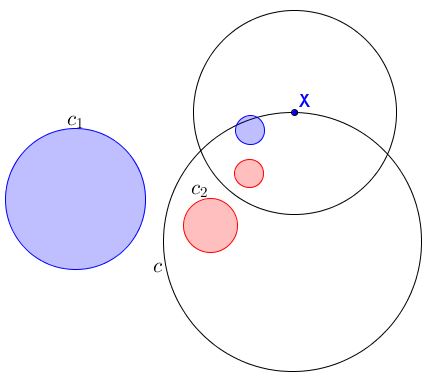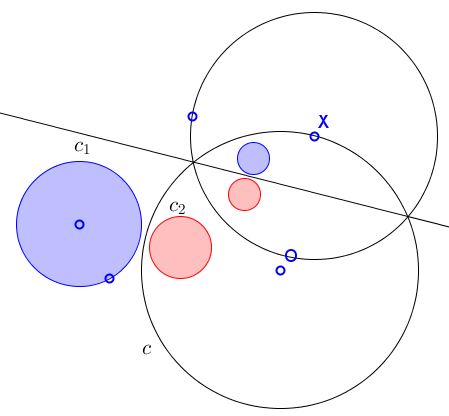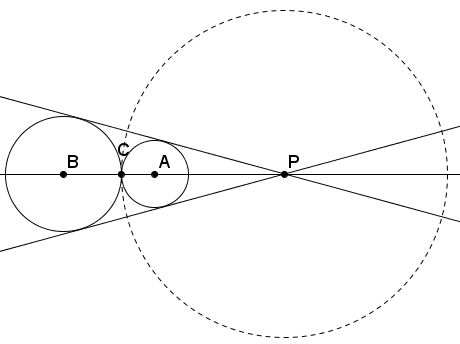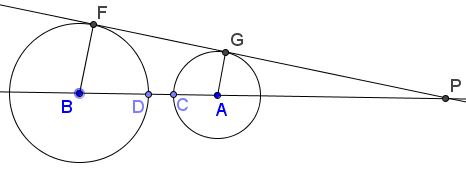Invert Two Circles Into Equal Ones
What is this about?
Problem
Assume that inversion in circle $c$ maps circle $c_1$ onto circle $c_2.$ Then, for any point $X\in c,$ any inversion with center $X$ maps $c_1$ and $c_2$ into equal circles.

Solution
A circle through the center of inversion maps onto a straight line. Thus circle $c$ becomes a straight line under inversion with center $X.$ Circles $c_1$ and $c_2$ are mapped into each other's reflections in this line, which are therefore equal.

Corollary
Any two circles of which neither is entirely within the other can be mapped into equal ones by two successive inversions.
The first inversion needs to map the given circles into each other. Next, we apply the already proved statement by choosing an arbitrary point on the circle of inversion as the center of the second transform.

The diagram above shows how to choose the circle of inversion for the first step when the two circles are tangent to each other. When they cross, the situation is analogous.
When the given circles do not have common points, consider the diagram below:

Let $R=BF$ and $r=AE.$ From the similarity of triangles $BFP$ and $AEP,$ $\displaystyle\frac{BP}{R}=\frac{AP}{r}=t,$ so that $BP=Rt$ and $AP=rt,$ for some positive $r.$ An inversion that maps circle $B(D)$ onto circle $A(C)$ maps $D$ onto $C.$ By definition, its radius $\rho$ should satisfy $\rho^{2}=CP\cdot DP=(t^{2}-1)Rr.$ It is easy to see that so defined radius determines the required inversion.
Acknowledgment
This is problem 3.8.15 from H. Eves, A Survey of Geometry.
Inversion - Introduction
- Angle Preservation Property
- Apollonian Circles Theorem
- Archimedes' Twin Circles and a Brother
- Bisectal Circle
- Chain of Inscribed Circles
- Circle Inscribed in a Circular Segment
- Circle Inversion: Reflection in a Circle
- Circle Inversion Tool
- Feuerbach's Theorem: a Proof
- Four Touching Circles
- Hart's Inversor
- Inversion in the Incircle
- Inversion with a Negative Power
- Miquel's Theorem for Circles
- Peaucellier Linkage
- Polar Circle
- Poles and Polars
- Ptolemy by Inversion
- Radical Axis of Circles Inscribed in a Circular Segment
- Steiner's porism
- Stereographic Projection and Inversion
- Tangent Circles and an Isosceles Triangle
- Tangent Circles and an Isosceles Triangle II
- Three Tangents, Three Secants
- Viviani by Inversion
- Simultaneous Diameters in Concurrent Circles
- An Euclidean Construction with Inversion
- Construction and Properties of Mixtilinear Incircles
- Two Quadruplets of Concyclic Points
- Seven and the Eighth Circle Theorem
- Invert Two Circles Into Equal Ones
|Contact| |Front page| |Contents| |Geometry|
Copyright © 1996-2018 Alexander Bogomolny73582343
